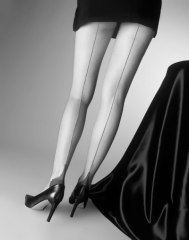Hosieree Article
HISTORY of HOSIERY
 |
The history of hosiery dates back as early as 280 AD when people first learned to knit.
They started knitting stockings to keep their legs warm, but these hose were a far cry from the
versions we wear today. Hose started to take the shape we know and love today in medieval times,
which is also when they took the name hose. In Medieval Europe any material that could be woven was used to create hose. These hose resembled socks much more than they resembled modern hosiery. They did not have a panty, either, and were held up by garters, strings, or ties at the belt. n the 1580s a reverend by the name William Lee invented a knitting machine. Now hose could be made quickly and efficiently, and silk stockings began to take precedent over the itchy, woolen variety of the past. Queen Elizabeth was the first monarch to wear silk stockings, and she loved them so much that she ruled that anyone who took the plans for Lee’s invention out of the country would be executed. Silk stockings were worn by both men and women, and they were sewn in a wide range of sizes. This is because they did not stretch, so in order to avoid sagging the hose had to be as form fitting as possible for each individual’s particular size. Hose also came in a wide range of colors, and women were never seen without their legs covered by hose. |
|
As history continued, hose were made from any woven fabric, including cotton, silk, and wool.
The hose were cut from a pattern and then sewn. Eventually someone invented a machine that could knit in a circle.
This machine created a long tube of fabric, but without something in the fabric to allow it to stretch,
hose sagged on just about every wearer. The world of hose continued in this fashion, with silk hose held up by garters as the most popular design worn by women, until the early 1900s when nylon was discovered. In 1937, a researcher for the DuPont Company found that heating a mixture of coal, air, tar, and water created a fiber that was strong and flexible, but also felt silky. These polymer fibers were exceptionally thin and could stretch. This material was called nylon, and immediately put to use to make hose. The nylon hose, or nylons as we call them today, hit the world scene at the 1939 World’s Fair. The next year they started selling the new hose in New York, and 72,000 pairs were purchased on the very first day they were on the market. After four days, four million pairs of nylons had been purchased. The new material was a hit because it stretched and conformed to the woman’s leg, rather than gathering and bunching like silk and cotton hose did. |
|
The introduction of the panty to the world of hosiery came in the 1950s. Introducing a built-in panty to a pair of
nylons eliminated the need for certain undergarments. The late fifties and early sixties were when Spandex was
discovered and added to hose. Yarn manufacturers realized that they could crimp heated yarn. This created a yarn
that could stretch and then return to its normal shape, making it perfect to incorporate into nylons. DuPont created
a Spandex that they called Lycra, which is still found in today’s nylons. Nylons of this era still had a seam up the back of the leg and the high Cuban heel, which protected the nylons from runs. When World War II hit, nylon was taken off the clothing market and was used only in production of war materials. Women missed the fashion statement their nylons made so much that they drew seams on the back of their legs with makeup pencils. However, in 1965 nylons dropped their seams when Glen Raven Mills introduced a pair that had no seam. As fashion became bigger and brighter in the sixties, so did hose. Women could buy hose with textures, patterns, and bright colors. Stripes and patterns with psychedelic colors were not uncommon. The legs and the hose they wore were the focus of the fashion world. |
 |
|
Today, nylons are worn mainly by women. Much more professional and empowering than socks, hosiery is considered the main
garment for women’s legs today. Stockings come in every shade, texture, and size imaginable. You can buy fishnet pairs for
those moments that you feel sensual, sparkling pairs for times that call for fun, and even control top hose for times you need
a little help controlling the bulge. Retro nylons with the high Cuban heel and the back seam are back, and considered quite
fashionable and sexy. You can even buy woolen and silk stockings to give you a taste of the days when nylons didn’t stretch,
but rather bulged and sagged. Whatever your tastes are, there is a pair of nylons to match! |
06/21/2007



